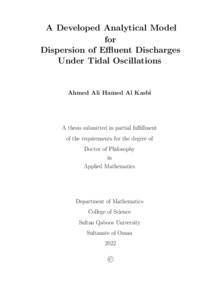Document
A Developed analytical model for dispersion of effluent discharges under tidal oscillations.
Publisher
Sultan Qaboos University.
Gregorian
2022
Language
English
English abstract
Dispersion of effluent discharges from sea outfalls has many potential environmental impacts on coastal zones. Understanding the dispersion process is critical to manage these impacts and can provide a useful way to minimize undesirable consequences. Beside several factors, tidal currents and depth topography play important roles on dispersion of discharged effluent in the far field region. Some important and complicated situations that arise when the coastal flow changes its direction due to tidal reversal. The effect of depth topography is due to the fact that dispersion process is more efficient in deep water, and effluent discharges are more likely to be retained in the shallower regions.
The main objective of this thesis is to employ a mathematical model for dispersion of effluent discharges under tidal oscillation
currents on a sloping beach using a two-dimensional time-dependent
advection-diffusion equation. The steady effluent discharges are assumed to be disposed from a point source to model a port of the
sea outfall into well-mixed waters.
A simple sinusoidal formulation has been used to express the tidal oscillation; however, tides and tidal currents are more com plicated and often contain oscillations of two (or more) different frequencies to create a spring-neap tidal cycle. Many field obser vations reported the vital role that is played by the spring-neap tidal current. In this study, the spring-neap tidal current formula tion is deployed to represent the tidal oscillation in coastal areas.
A time-varying discharge strategy and compounded concentration from two outfalls, and via two-port diffuser as well, are included inthis investigation as practical engineering applications of the model.
For a uniformly sloping beach, the cross-shore current veloc ity and turbulent dispersivity are considered as functions of water
depth and approximated by power laws. The separation of variables approach was applied to get a pair of advection-diffusion equations in one dimension. In the x-direction, the equation is solved analytically utilizing the Fourier transform. While in the y-direction with spatially variable velocity and dispersion coefficient, the Laplace transform is employed to get the solution.
The analytical solution is presented graphically by contour plots of concentration to visualize the dispersion of effluent discharges in coastal waters. The concentration at the shoreline and at the centerline of the plume are examined by varying the model parameters.
Member of
Resource URL
Category
Theses and Dissertations

